
The Ultimate New Puppy Checklist
Congratulations! Your new puppy is on its way or arriving soon. If you’ve never had a puppy before, you’re in for the ride of your life!
To help get you ready, Keeping It Pawsome has put together this ultimate new puppy checklist of everything you’ll need either before puppy arrives or within the first few days.
(The following article contains affiliate links. We receive a small commission if you make any purchases.)
Quick List
| 1. Bed | 10. Nail Clipper |
| 2. Bowls (food & water) | 11. Pee Pads |
| 3. Brush | 12. Poop Bags |
| 4. Carpet Cleaner | 13. Puppy Food |
| 5. Collar | 14. Puppy Gate |
| 6. Crate | 15. Shampoo |
| 7. Dog Tags | 16. Teeth Cleaner |
| 8. Harness | 17. Toys |
| 9. Leash |
Bed
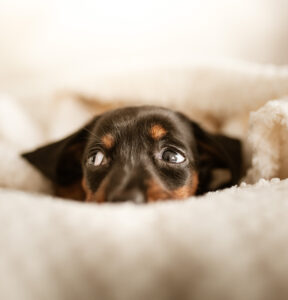
Who doesn’t like a comfy bed? This holds true for dogs and we recommend getting a couple for your new pup. At a minimum, you’ll want something for her crate to make it more comfortable and homier. You’ll find more than 25 styles/brands reviewed on SparkysSpots.com.
If you think that you want your pup napping with you while you watch TV, rather than in her crate, you’ll want to get a dog bed for the living room or bedroom — or wherever it is you’re hoping she’ll curl up.
As with most puppy things, we don’t recommend spending too much money up front as you never know what your dog will or won’t like. With that said, you might also want to look for something that’s chew-resistant and waterproof (just in case!).
It could take some experimenting before you find the right style for her.
Bowls
Two of the most essential items you’ll need the minute your puppy arrives home are food and water bowls.
Because your pup will probably be rambunctious, curious and likely to chew, we advise starting with a stainless-steel bowl that has a rubber bottom. The stainless steel will hold up against your eager chewer, while the no-slip bottom will make it harder for her to push the bowl around or tip it over.
Shallow, wide bowls are best for most puppies; its just easier for them to reach their food. But keep in mind the size of your dog’s head when making your purchase. Little puppies don’t need giant bowls; but a Newfoundland puppy’s head isn’t going to fit into a soup-bowl sized dish.
When selecting a water bowl, again keep in mind the size of your puppy’s head, but also make sure its big enough to fill with enough water to last at least 12 hours.
Brush
Even if you plan on bringing your puppy to a groomer (which you really shouldn’t do until he’s had all his shots), you’ll want to have a brush in the house — especially if you’ve gotten a puppy with long fur.
Brushing is also a great way to bond with your fur baby.
Take a peek at the best, most adorable Halloween costumes for dogs.
Carpet Cleaner
There’s really now way around it. If you’ve got a puppy, there’s a decent chance you’ll be cleaning up an accident at some point. Where possible, consider limiting your puppy’s access to harder-to-clean surfaces — like hardwood, which will stain if urinated on.
While having to clean up a mess from a carpet isn’t fun, it’s not the end of the world. You can find specially-formulated carpet cleaners designed specifically for dog (or cat) messes. If you’ve got a carpet and your new puppy is going to have access to it, we suggest having carpet cleaner on hand before you wind up needing it!
Collar

As your puppy grows, he’s going to go through lots of collars. To start off with, choose a flat, adjustable, nylon dog collar. We suggest going with a standard width of 1.5 inches to start with, unless your dog has a really big neck. This will get her used to wearing a collar, while you decide if you want something fancier down the road.
If you plan to let your pup play outside a lot, consider adding in a breakaway collar to the mix, so that if he gets caught in the fence or on a branch, the collar will come undone before he can choke himself. (This is true, also, if you plan to leave the collar on your puppy when you’re out of the house.)
If you can, get the approximate measurement of your new pup’s neck (while she’s standing) before you buy the collar. If you can’t, you’ll need to pick one that’s roughly corresponds to her size. Getting a Chihuahua pup, for instance? You’ll want the smallest sized collar. A Saint Bernard pup, go for something larger.
Crate
Crate training is one of the greatest gifts you can give your new puppy — and yourself. Descendants of den-dwelling wolves, dogs instinctively retreat to small spaces when scared or stressed, or just need some time to themselves to relax. Crates also keep puppies safe when you can’t supervise them.
But more importantly — at least as it relates to puppies — they are an important part of housebreaking training. Whenever possible, dogs will avoid dirtying their sleeping area. Which means your puppy will, by necessity, learn to hold his bladder when he’s crated, a lesson you can carry over to the rest of the house.
Many crates — mostly of the metal variety — come with dividers so your pup can grow into the crate. You don’t want a puppy to have full access to a large crate as he may discover he doesn’t mind doing his business at one end and sleeping at the other.
You’ll need to have an approximate idea of how long your dog will be as an adult, something that’s easier with a pure breed than a mixed-breed dog. The crate should be big enough for you to put a dog bed inside, and still be easy for your dog to stand and turn around in.
Crates come in a variety of materials, but which you’ll want/need can depend. Will you be traveling with your dog? (Plastic or soft-sided crates are usually better for that, though not always!) Will the crate always be in one spot? (Metal crates are better for that, usually.) Will your dog grow up to be especially strong? (Consider a heavy-duty plastic option.)
You may want to do some further research or talk to a store associate when deciding what material to get.
Dog Tags
You might think your pup doesn’t need dog tags until he’s older and going for regular walks. Unfortunately, you never know when he’ll dart out the door or get through a loose plank in the fence.
The best way to ensure he gets home is to have a dog tag on his collar with his name, your name and your telephone number. It’s up to you whether you also want to put your address on the collar.
This way when someone finds him wandering around, they’ll know who to contact, reducing the chances he’ll end up at a shelter or with the local police (who will take him to a shelter).
Harness
If you plan on taking your puppy anywhere in the car, you’ll want a harness so that you can keep him safe. Car harness’ wrap around you dog’s chest, similar to a walking harness, but are sturdier and spread over a larger area of your dog’s body in order to protect him from serious injury during a collision.
This is one product we don’t recommend skimping on. You want a quality car harness that will protect your pup, despite the fact he will grow out of the first one you purchase. We also suggest waiting until you have your puppy to get purchase one so that you can buy the right size without having to guess. (You’ll need to know neck width and weight do determine the right size.)
Some people also choose to use a harness when walking their dog. This is particularly true for those with larger, stronger breeds known for pulling at their leash when they walk. A harness cuts down on some of the pulling. While you probably won’t be having that problem with your puppy just yet, if he is a breed that could do that, you’ll want to get him used to a harness earlier rather than later.
Check out the list of the top-rated dog car seats available on Amazon.
Leash
As with puppy dog collars, we recommend starting your pup with a cheap, lightweight leash. You don’t need a retractable one just yet, since the first step in leash training is simply getting her used to something attached to her collar. Generally speaking, you’ll want to start with a shorter leash (four to six feet), so it’s easier to teach her not to pull and to heal.
Nail Clipper
If you plan on having a groomer or your vet trim your dog’s nails you probably don’t really need a nail clipper. But it’s always a good idea to dogs used to having someone handle their paws and try to clip their nails before actually putting them into a stranger’s hands and expecting them to sit still for it.
If you’re going to be doing the trimming yourself, you’ll want to find a clipper that corresponds to your puppy’s size. With small puppies, you can –and should — use a human nail clipper. If you’re unsure of how to clip your puppy’s nails, ask your vet for a demo.
Pee Pads
See carpet cleaner above. Accidents gonna happen and like the old adage says, the best defense is a strong offense. Not all trainers agree that pee pad training is the best course of action, but we believe it’s always better to have them on hand in case they’re needed.
Don’t put them in your puppy’s crate, but if you know your pup might not make it until you can next take him outside, pick a designated spot he can use and put the pee pads there. As he gets better at holding it for longer, you’ll need them less and less.
Poop Bags
Rather self-explanatory. If you’ve got a steady stream of grocery store plastic bags, feel free to use them. If you’ll be purchasing bags, we recommend biodegradable options.
Puppy Food
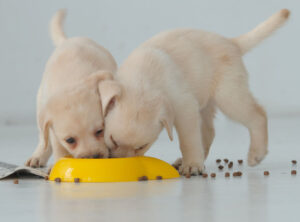
An obvious entry on any new puppy checklist. The options are endless. Choices include dry kibble, wet food, raw diets, human-grade fresh food, and even DIY meals.
If you’re adopting a rescue, ask the group what they’ve been feeding him. Purchasing your pup from a breeder? See what they recommend for his breed. You can also talk to your pup’s vet about food choices, or ask other dog parents what they feed their fur babies.
As your puppy gets older, you’ll get to know his likes and dislikes better, as well get a better grip on your own priorities when it comes to dog food.
Puppy Gate
You’ll only need a puppy gate if you need to keep your pup out of a part of the house that can’t otherwise be closed off. You’ll want your gate to stand up to your puppy’s attempts to get through. The bigger and stronger your dog, the bigger and stronger the gate needs to be. For small dogs, a baby gate will also work.
Gates can also be used to keep small puppies off of stairs until she’s big enough to go up and down without hurting herself.
If you’re going to be keeping you fur baby out of this space permanently, match the gate to her anticipated adult size.
Shampoo
Puppies can be bathed starting at 3 months old. No need to purchase puppy-specific shampoo, but you do want to have dog shampoo on hand. (Just steer clear of medicated shampoos until he’s older.) Especially if you plan on letting your pup into a backyard or even the dog park. Your puppy is going to get himself into everything he can, including rolling around in the dirt (or worse, mud!).
Teeth Cleaner
Keeping your dog’s teeth clean is an important piece of keeping him healthy. And the best time to get him used to having them brushed is when he’s a puppy. We highly recommend starting him off right, with a toothbrush and doggy tooth paste as this will give you the best results over the course of his life.
But if you’re uncomfortable with brushing his teeth, at least make sure to have some moistened teeth wipes, which you can use to wipe his teeth down.
Not sure how to get started with tooth brushing? Check out this video.
Learn more about caring for your dog’s teeth if you can’t brush them.
Toys
Last, but certainly not least, you want to have a variety of toys for your puppy to play with including those he can chew and those he can chase.
For chew toys in particular, make sure you choose those designed specifically for delicate puppy teeth.
See more about chew toy safety for dogs.
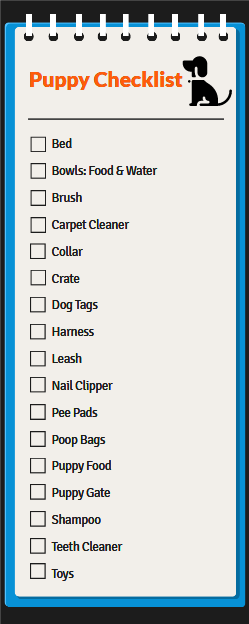
4 Comments
Comments are closed.
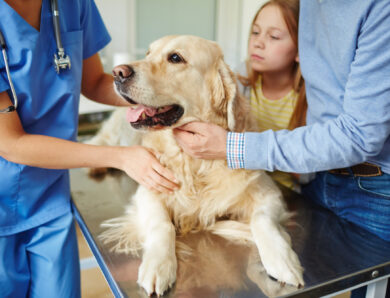
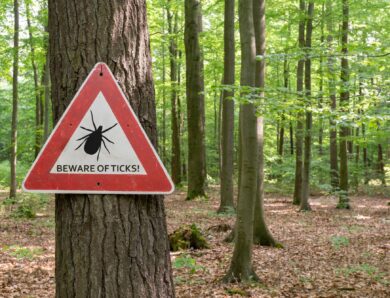
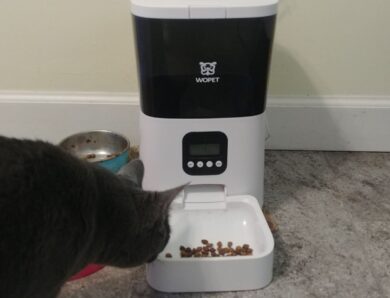
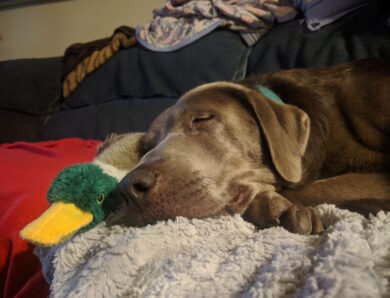


What a great list! I think you covered everything. We crated trained our pup and agree, it was the best decision for her. So glad you remembered the TOYS – that is the best part. Well, that and the Halloween costumes.
oh wow, I could have so used this checklist a few months ago:) We got a new puppy in like an hour notice and it there was a LOT of adjusting and a steep learning curve (as first-time puppy parents) for us to do. Such great info in here.
I love this checklist and all the great information! We have two senior dogs so no new puppies right now, but eventually we will be getting another puppy and I am going to keep this checklist for when we do! Thank you!
If I ever get a puppy, this list will help me be prepared.